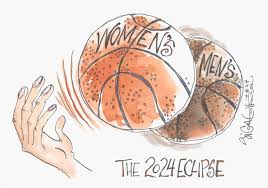1
Section One: The Fundamentals
A) What do we know about sport? What are common assumptions we make about sport and society?
Exercise 3: Notebook prompt
What are some other metanarratives about sport that you are familiar with? Find an image or video clip or draw something yourself that captures this idea…
So what? Why does any of this matter? Does it matter? As something we grow up with – live with – play through – we don’t often interrogate the meanings of sport, and perhaps we don’t want to.
But being aware of these assumptions and metanarratives is especially important, I would argue, because of the centrality of sport to our everyday lives, the role that sport plays in shaping our childhood and worldviews and….. [finish that thought]
| Some other metanarratives about sport include the idea of sport as a vehicle for upward mobility, a tool for national pride, and a proving ground for masculinity. This matters because sport isn’t just a pastime; it shapes our identities, cultural values, and beliefs about fairness and competition. Being aware of these narratives is crucial because sport plays a significant role in normalizing societal power dynamics and shaping how we understand concepts like race, gender, and merit. By interrogating these assumptions, we can challenge the exclusionary practices and ideologies often hidden beneath the surface of our everyday games.
|
B) What is social justice?
Exercise 4: Padlet Prompt
Think back to the last section and try to look at some of the ideas we discussed differently. How might sport and social justice actually co-exist?
Record any images, video clips, or gifs you added to the padlet and identify a point of intersection between sport and social justice (can be an issue or a barrier or a debate or something you would like to explore in more depth in this course) . Screenshot or paste in your response below.
| A key intersection between sports and social justice is access and accessibility for individuals with disabilities. Barriers like the lack of adaptive programs, inaccessible facilities, and stigmas often limit participation. Many venues lack accommodations such as wheelchair ramps, specialized equipment, or trained coaches. Additionally, the disparity in funding and media coverage for adaptive sports highlights systemic inequalities. Exploring this issue could involve examining initiatives like the Paralympic Games, the impact of policies like the Americans with Disabilities Act (ADA), and ongoing gaps in creating inclusive sports environments. |
C) Social Justice Reading
(note: this activity is optional!)
D) KINESIOLOGY AND SOCIAL JUSTICE
Exercise 5:
Exercise 6:
What are the implications of bodies-at-risk discourse and the refusal to understand the health gap from a social justice perspective, according to the authors of this article?
| The bodies-at-risk discourse, as discussed by the authors, frames marginalized groups, such as ethnic minorities, women, and individuals with disabilities, as deficient, irresponsible, or inherently flawed for failing to meet health norms shaped by White, middle-class ideals. This deficit-oriented model positions these groups as problems to be fixed rather than examining the structural inequities and systemic barriers that contribute to health disparities. Furthermore, the refusal to view the health gap through a social justice lens marginalizes diverse perspectives and experiences, silencing the voices of oppressed groups and obscuring the necessity for equitable, inclusive, and culturally informed interventions. This approach not only perpetuates inequity but also undermines efforts to address the root causes of health disparities in meaningful ways.
|
Section Two: Sport Feminism
Exercise 7: Notebook Prompt
What is feminism? What does it mean to you? Choose one of the images below and explain how it captures your understanding of feminism (or find one that does speak to you and paste this into your pressbook with an explanation of why it matters to you.
| Feminism is a movement and ideology that advocates for equality between all genders, challenging systems of oppression that perpetuate discrimination and inequality. It emphasizes women’s empowerment, autonomy, and the right to participate fully in social, political, and economic life. To me, feminism is about dismantling barriers and creating a world where everyone, regardless of gender, has equal opportunities and rights. The image of “We Can Do It!” perfectly encapsulates this understanding of feminism. It portrays strength, resilience, and empowerment, showing a woman breaking traditional gender stereotypes by stepping into roles typically reserved for men. This image symbolizes the fight for equality and the idea that women are capable of contributing in all domains of life, challenging societal norms and expectations. It represents collective empowerment and the assertion of agency, which are central to feminism.
|
Exercise 8: Notes Prompt (optional)
NB: Cornell notes is a great resource that teaches effective notetaking. Unfortunately, our system can’t save notes taken in the H5P app, so this is fully optional.
Exercise 9: Crossword Activity
Exercise 10: Padlet Prompt
| What stood out to me in the article is how it looks at the connections between gender, feminism, and sports to explore bigger social issues. Words like inequalities, representation, and access kept coming up because the article really focuses on how gendered expectations and stereotypes shape who gets to participate in sports and how. It also talks a lot about liberal feminism, which pushes for equality through things like changing policies and creating fair opportunities.I also noticed a focus on terms like masculinities and femininities, showing how sports often reflect traditional gender roles. Words like socialization and stereotyping stuck out because they show how these ideas are passed down and reinforced. On the flip side, there’s also a lot about physicality and empowerment, emphasizing how sports can challenge norms and give people a sense of agency. Overall, these words stood out because they reflect the article’s mix of critiquing the barriers people face in sports and highlighting the push for more inclusion and opportunities.
|

|
|

